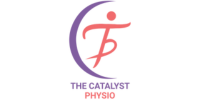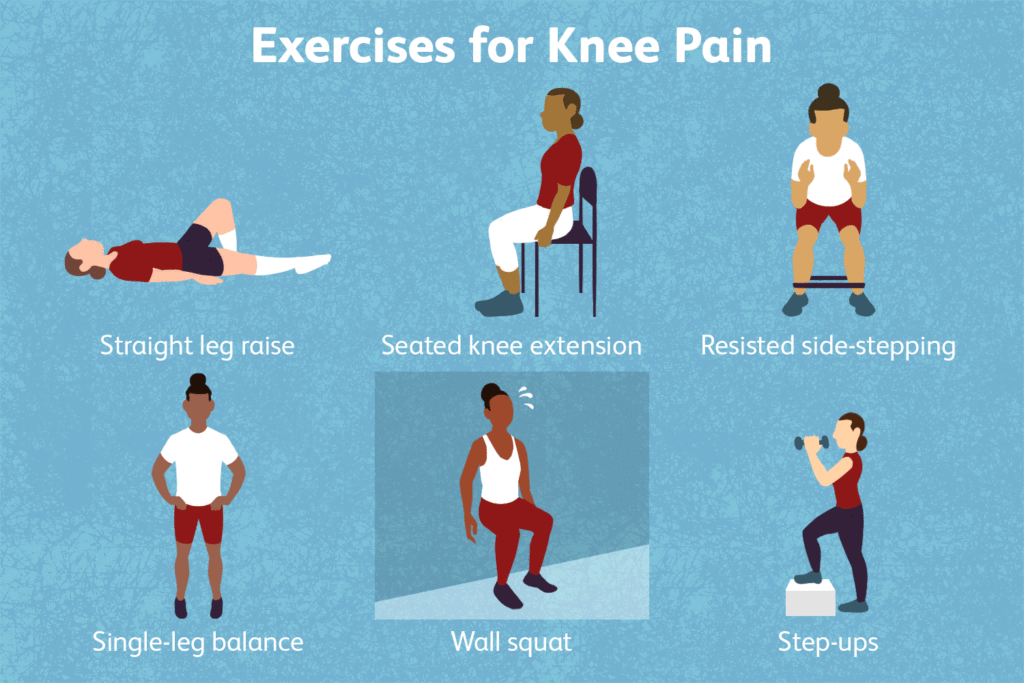Introduction
When knee pain strikes, finding relief becomes a top priority. Physiotherapy at home can be an effective way to manage knee pain and promote healing. By incorporating targeted activities into your daily routine, you can strengthen the muscles around your knee, improve flexibility, and reduce discomfort. Here are the top 10 best activities for knee pain physiotherapy at home:
1. Quadriceps Sets

Quadriceps sets are a fundamental exercise in Knee Pain Physiotherapy at Home, specifically targeting the quadriceps muscles to aid in pain relief and improve joint function. Here’s how to perform them effectively:
- Position: Sit or lie down comfortably on a flat surface, ensuring proper support for your back.
- Form: Straighten your legs out in front of you, keeping them parallel to each other.
- Engagement: Contract the muscles on the front of your thigh (quadriceps) by pressing the back of your knee towards the floor or surface beneath you.
- Hold: Maintain this contraction for about 5-10 seconds, focusing on engaging the quadriceps muscles as much as possible.
- Release: Relax the muscles gradually after holding the contraction, allowing them to rest for a few seconds.
- Repetition: Repeat the exercise for 10-15 repetitions per set, aiming for at least 2-3 sets per session.
Performing quadriceps sets regularly as part of your Knee Pain Physiotherapy at-home regimen can help strengthen the muscles surrounding the knee joint, leading to improved stability, reduced discomfort, and enhanced mobility over time.
2. Straight Leg Raises

Straight leg raises are an effective exercise in knee pain physiotherapy, targeting the quadriceps and hip flexor muscles to improve strength and stability around the knee joint, This exercise also fixes back pain physiotherapy at home. Here’s how to perform them correctly:
- Starting Position: Begin by lying flat on your back on a comfortable surface, such as a yoga mat or bed.
- Leg Alignment: Keep one leg bent with your foot flat on the surface while extending the other leg fully straight out in front of you.
- Engagement: Tighten your thigh muscles, particularly focusing on the quadriceps of the extended leg.
- Lift: Slowly raise the straight leg off the surface, keeping it aligned with the bent leg and the rest of your body. Aim to lift the leg to a height where it is parallel to the bent knee.
- Hold: Once you’ve reached the top position, hold for a brief moment, ensuring to engage the muscles throughout.
- Lower: Slowly lower the leg back down to the starting position with control, avoiding any sudden movements.
- Repetition: Perform 10-15 repetitions on each leg, gradually increasing the number of sets as you progress and feel more comfortable with the exercise.
Straight leg raises are excellent for strengthening the quadriceps and improving knee stability, making them a valuable addition to any knee pain physiotherapy routine.
3. Hamstring Curls
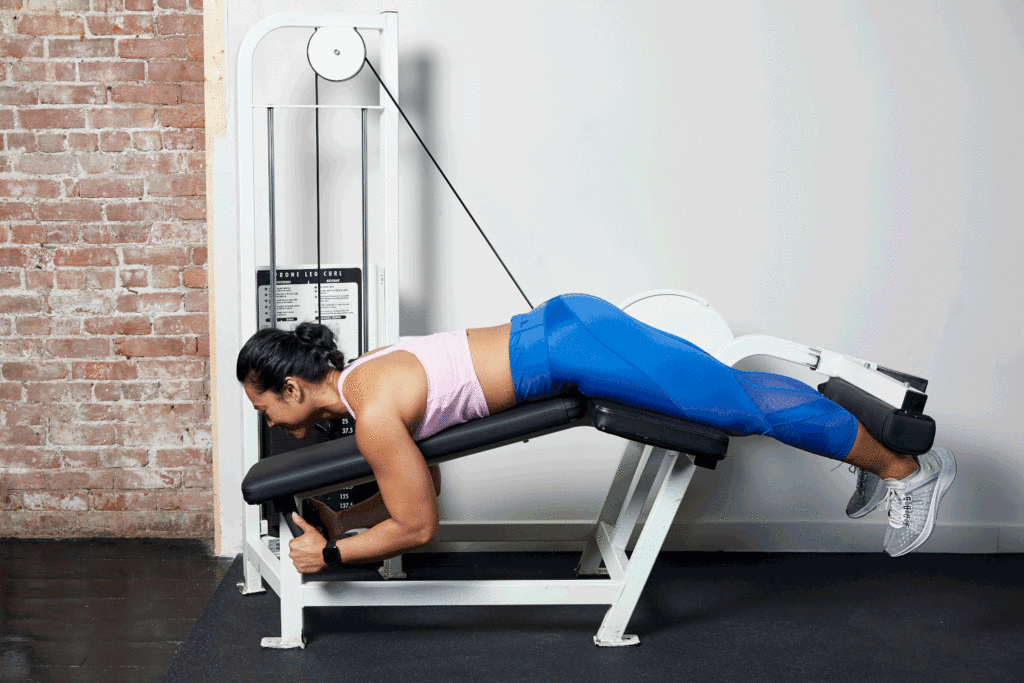
Hamstring curls are a beneficial exercise in Knee Pain Physiotherapy at Home, targeting the muscles at the back of the thigh to enhance stability and support around the knee joint. Here’s how to perform hamstring curls effectively:
- Starting Position: Begin by lying face down on a flat surface, such as a mat or exercise bench, with your legs fully extended.
- Leg Alignment: Position your legs hip-width apart and ensure that your toes are pointing towards the floor.
- Engagement: Engage your core muscles to stabilize your body throughout the exercise.
- Bend Knee: Bend one knee, bringing your heel towards your buttocks as far as comfortably possible, while keeping the rest of your body stationary.
- Contract: Squeeze the muscles at the back of your thigh (hamstrings) as you bring your heel towards your buttocks, focusing on the contraction.
- Hold: Hold the peak position for a brief moment, maintaining tension in the hamstrings.
- Lower: Slowly lower your leg back to the starting position with control, ensuring a smooth and controlled movement.
- Alternate Legs: Repeat the same movement with the opposite leg, alternating between legs for the desired number of repetitions.
- Repetition: Aim to perform 10-15 repetitions on each leg, gradually increasing the number of sets as you progress and become more comfortable with the exercise.
Hamstring curls are effective for strengthening the muscles at the back of the thigh, which can help improve knee stability and alleviate knee pain when performed regularly as part of a comprehensive physiotherapy program.
4. Seated Leg Extensions
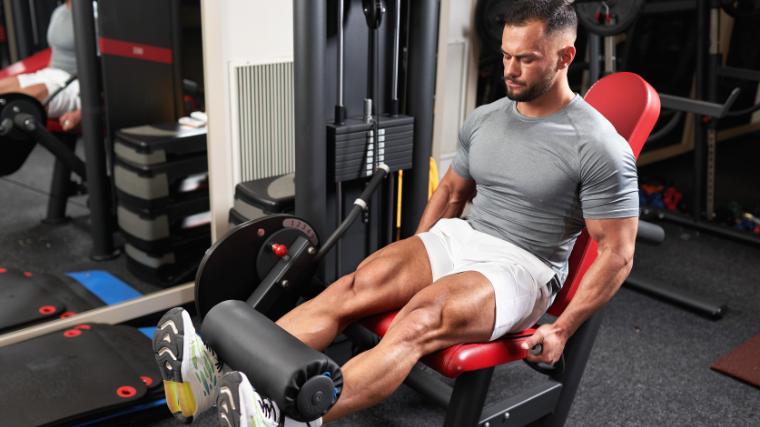
Seated leg extensions are a valuable exercise in knee pain physiotherapy at home, specifically targeting the quadriceps muscles to enhance strength and stability around the knee joint. Here’s how to perform seated leg extensions effectively:
- Starting Position: Sit on a sturdy chair or bench with your back straight and feet flat on the floor.
- Leg Alignment: Position your thighs parallel to the ground and ensure your knees are bent at a 90-degree angle.
- Engagement: Engage your core muscles to stabilize your body throughout the exercise.
- Extension: Slowly extend one leg forward, straightening it out in front of you while keeping your foot flexed.
- Hold: Hold the extended position for a brief moment, focusing on contracting the quadriceps muscles at the front of your thigh.
- Lower: Slowly lower your leg back to the starting position with control, ensuring a smooth and controlled movement.
- Alternate Legs: Repeat the same movement with the opposite leg, alternating between legs for the desired number of repetitions.
- Repetition: Aim to perform 10-15 repetitions on each leg, gradually increasing the number of sets as you progress and become more comfortable with the exercise.
Seated leg extensions effectively target the quadriceps muscles, which play a crucial role in knee stability and function. Incorporating this exercise into your knee pain physiotherapy routine can help improve strength and alleviate discomfort over time.
5. Wall Squats
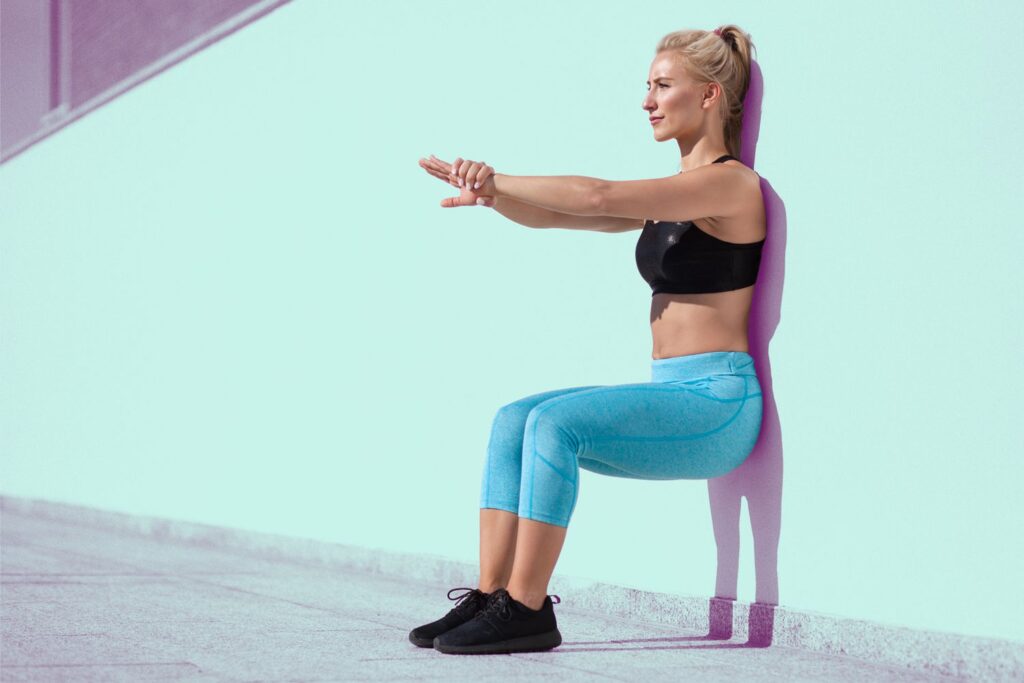
Wall squats are an excellent exercise in knee pain physiotherapy, targeting multiple muscle groups including the quadriceps, hamstrings, and glutes to improve strength and stability around the knee joint. Here’s how to perform wall squats effectively:
- Starting Position: Stand with your back against a sturdy wall and your feet shoulder-width apart.
- Wall Contact: Ensure your entire back is in contact with the wall, and your feet are positioned slightly in front of you.
- Alignment: Keep your knees aligned with your ankles and your spine straight throughout the exercise.
- Engagement: Engage your core muscles to stabilize your body, and keep your shoulders relaxed.
- Lowering: Slowly lower your body by bending your knees, as if you are sitting back into an imaginary chair. Keep your back against the wall and your knees tracking over your toes.
- Depth: Lower yourself down until your thighs are parallel to the ground, or as far as comfortable without causing pain.
- Hold: Hold the squat position for a few seconds, focusing on maintaining proper form and engaging the leg muscles.
- Rising: Push through your heels to return to the starting position, straightening your legs and standing tall against the wall.
- Repetition: Aim to perform 10-15 repetitions, gradually increasing the number of sets as you build strength and endurance.
You can Hire a Physiotherapist in Delhi With Affordable Charges Wall squats are a low-impact yet effective exercise for strengthening the muscles around the knee joint, promoting better stability and reducing discomfort. Incorporate them into your knee pain physiotherapy routine to experience improved function and mobility over time.
6. Step-Ups

Step-ups are a functional exercise that can be highly beneficial in knee pain Home physiotherapy, focuses on strengthening the muscles around the knee joint and improving stability. Here’s how to perform step-ups effectively:
- Platform Selection: Choose a sturdy platform or step that is about knee height or slightly lower. Ensure it can support your weight safely.
- Positioning: Stand facing the step with your feet hip-width apart and your shoulders relaxed.
- Engagement: Engage your core muscles to stabilize your body throughout the exercise.
- Leading Leg: Step onto the platform with one foot, ensuring the entire foot is placed firmly on the step.
- Extension: Push through the heel of the leading leg to lift your body onto the step, straightening the leg completely.
- Trail Leg: Bring the trailing leg up onto the step, ensuring both feet are fully on the platform.
- Controlled Descent: Step back down from the platform with the trailing leg first, followed by the leading leg. Lower yourself with control, avoiding any sudden movements.
- Repetition: Perform 10-15 repetitions on each leg, alternating between legs for a balanced workout.
Step-ups are effective for strengthening the quadriceps, hamstrings, and glutes, all of which play a crucial role in knee stability and function. Incorporating this exercise into your Knee Pain Physiotherapy at Home routine can help improve strength, balance, and overall mobility over time.
7. Calf Raises
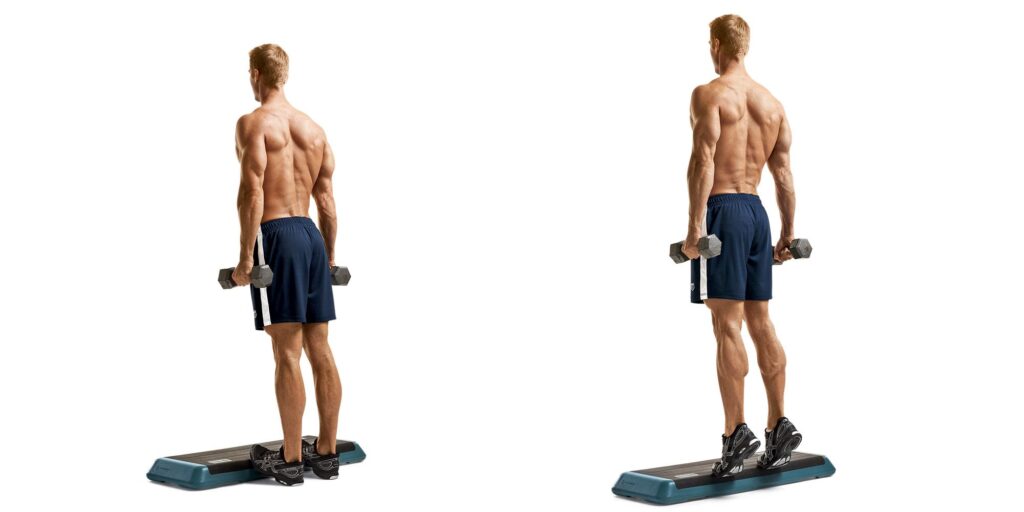
Calf raises are a simple yet effective exercise that can aid in knee pain physiotherapy by strengthening the calf muscles and improving overall stability around the knee joint. Here’s how to perform calf raises correctly:
- Starting Position: Stand upright with your feet hip-width apart and your arms hanging naturally by your sides.
- Engagement: Engage your core muscles to stabilize your body throughout the exercise.
- Lift: Slowly rise up onto the balls of your feet, lifting your heels off the ground as high as you can comfortably go.
- Hold: Hold the raised position for a moment, focusing on squeezing your calf muscles at the top of the movement.
- Lowering: Slowly lower your heels back down to the starting position, maintaining control over the movement.
- Repetition: Aim to perform 15-20 repetitions in a controlled manner, ensuring a full range of motion with each repetition.
- Variations: To target different areas of the calf muscles, you can perform calf raises with your toes pointed straight ahead, turned slightly inward, or turned slightly outward.
Calf raises can help strengthen the muscles in the lower leg, including the calf muscles, which provide crucial support to the knee joint. Incorporating this exercise into your knee pain physiotherapy routine can contribute to improved stability and reduced discomfort over time.
8. Balance Exercises
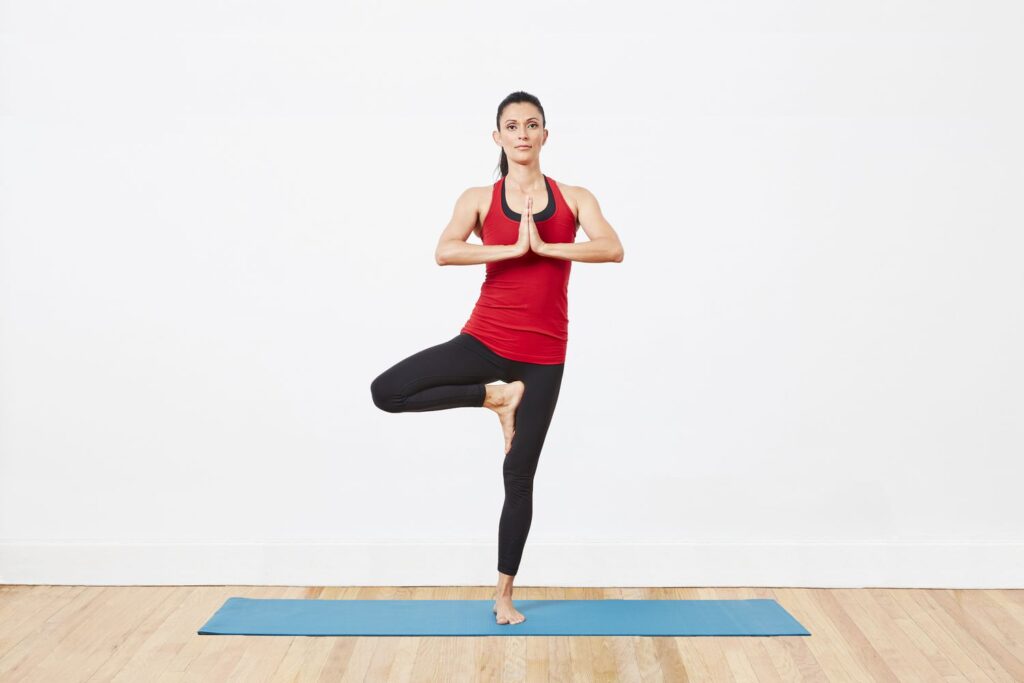
Balance exercises are an integral part of knee pain physiotherapy at home, focusing on improving proprioception and stability to reduce the risk of falls and enhance overall knee function. Here are some effective balance exercises to incorporate into your routine:
- Single-Leg Stands:
- Stand upright with your feet hip-width apart.
- Lift one foot off the ground and balance on the opposite leg.
- Hold the position for 30 seconds to 1 minute, then switch legs.
- Focus on keeping your core engaged and maintaining a steady balance throughout.
- Heel-to-Toe Walks:
- Position yourself in a straight line, placing one foot directly in front of the other so that the heel of one foot touches the toes of the other.
- Take slow, deliberate steps forward, maintaining the heel-to-toe alignment.
- Aim to walk for 10-15 steps in one direction, then reverse and walk back.
- Focus on keeping your gaze forward and your core muscles engaged to help maintain balance.
- Balance Board Drills:
- Stand on a balance board or wobble board with your feet hip-width apart.
- Shift your weight from side to side or front to back, maintaining your balance on the board.
- Start with small movements and gradually increase the range of motion as you become more comfortable.
- Perform 1-2 minutes of balance board drills, focusing on stability and control.
- Standing Knee Flexion:
- Stand upright with your feet hip-width apart and your hands resting on a stable surface for support if needed.
- Lift one foot off the ground and bring your heel towards your buttocks, bending your knee as much as possible.
- Hold the position for a few seconds, then slowly lower your foot back down.
- Repeat on the opposite leg, aiming for 10-15 repetitions on each side.
Incorporating these balance exercises into your knee pain Home physiotherapy routine can help improve proprioception, strengthen the muscles around the knee joint, and reduce the risk of falls or injuries. Start with simple exercises and gradually progress as your balance and stability improve over time.
9. Knee Flexion Stretch
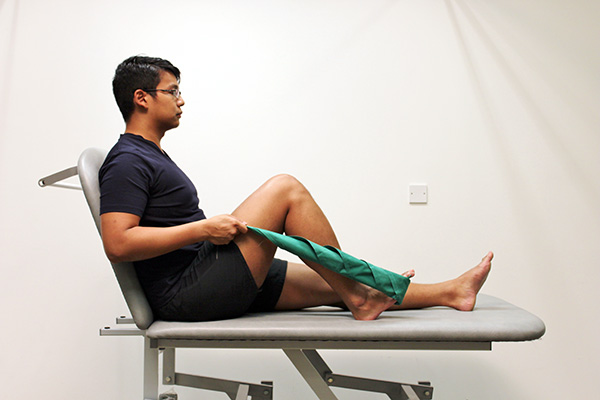
The knee flexion stretch is a beneficial exercise in knee pain physiotherapy at home, focusing on improving flexibility and reducing stiffness in the muscles around the knee joint. Here’s how to perform the knee flexion stretch effectively:
- Starting Position: Sit on the floor or a comfortable surface with both legs extended in front of you.
- Leg Positioning: Bend one knee and bring the heel of that foot towards your buttocks, allowing the knee to bend as much as possible.
- Grasp the Ankle: Reach back with the same-side hand and grasp the ankle of the bent leg.
- Gentle Pull: Slowly and gently pull the ankle towards your buttocks, increasing the stretch in the front of the thigh and the knee.
- Hold: Hold the stretch for 20-30 seconds, focusing on relaxing into the movement and breathing deeply.
- Release: Gradually release the stretch and return the foot to the starting position.
- Repeat: Perform the stretch on the opposite leg, following the same steps.
- Repetition: Repeat the knee flexion stretch 2-3 times on each leg, aiming to increase the intensity of the stretch gradually with each repetition.
The knee flexion stretch can help improve flexibility in the quadriceps muscles and reduce tension in the knee joint, leading to increased mobility and decreased discomfort over time. Incorporate this stretch into your knee pain physiotherapy routine, especially after engaging in strengthening exercises, to promote optimal recovery and rehabilitation.
10. Foam Rolling
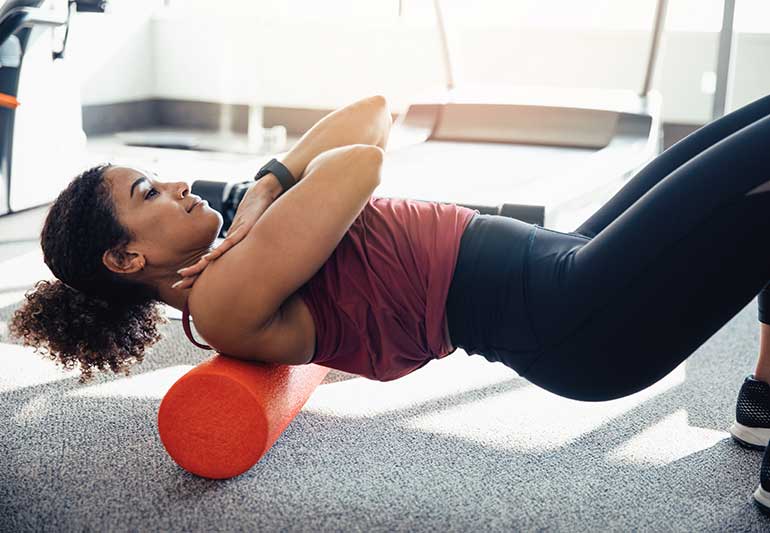
Foam rolling is a self-myofascial release technique that can be highly beneficial in knee Pain Physiotherapy at Home, helping to alleviate tightness and tension in the muscles surrounding the knee joint. Here’s how to perform foam rolling effectively:
- Choose the Right Roller: Select a foam roller that is firm enough to provide adequate pressure but not too hard that it causes discomfort.
- Starting Position: Sit on the floor with the foam roller placed horizontally beneath your knees.
- Engage Core: Engage your core muscles to stabilize your body throughout the exercise.
- Rolling Technique:
- Using your hands for support, slowly roll the foam roller up and down the length of your thighs, focusing on the quadriceps muscles at the front of the thigh.
- Apply gentle pressure as needed, especially on any areas of tightness or discomfort.
- Continue rolling for 1-2 minutes, gradually increasing the duration as tolerated.
- Target Specific Areas: To target specific areas of tightness or discomfort, you can adjust the angle of your body and shift your weight slightly to one side or the other.
- Breathe and Relax: Remember to breathe deeply and relax into the foam rolling movement, allowing the muscles to release tension.
- Avoid Direct Knee Pressure: Avoid rolling the foam roller directly over the knee joint itself to prevent excessive pressure on the knee cap and surrounding structures.
- Frequency: Regularly incorporate foam rolling into your knee pain physiotherapy routine, ideally after completing strengthening or stretching exercises.
Foam rolling can help improve blood circulation, reduce muscle tightness, and enhance mobility in the muscles surrounding the knee joint. By incorporating foam rolling into your knee pain physiotherapy regimen, you can experience improved comfort and function over time.
Conclusion
Incorporating these best activities for knee pain physiotherapy at home into your daily routine can help improve strength, flexibility, and overall knee health. Remember to start slowly and gradually increase intensity as tolerated, and always listen to your body. If you experience severe or persistent knee pain, be sure to consult with a healthcare professional for further evaluation and treatment options.
rom quadriceps sets and straight leg raises to balance exercises and foam rolling, each activity serves a unique purpose in supporting knee health and function. By engaging in these exercises regularly and progressively increasing intensity as tolerated, you can effectively manage knee pain, enhance joint mobility, and reduce the risk of future injuries.
FAQ About Knee Pain Physiotherapy at Home
1. What is knee pain physiotherapy?
Knee pain physiotherapy involves a variety of exercises and activities aimed at relieving discomfort, improving mobility, and promoting overall knee health. These exercises can be performed at home under the guidance of a healthcare professional.
2. Can I do physiotherapy for knee pain at home?
Yes, many effective physiotherapy exercises for knee pain can be performed at home with minimal equipment. However, it’s essential to consult with a healthcare professional to ensure you’re performing the exercises correctly and safely.
3. What are some effective exercises for knee pain physiotherapy at home?
Some effective exercises include quadriceps sets, straight leg raises, hamstring curls, seated leg extensions, wall squats, step-ups, calf raises, balance exercises, knee flexion stretches, and foam rolling.
4. How often should I do knee pain physiotherapy exercises at home?
The frequency of exercises will depend on your individual needs and the recommendations of your healthcare provider. Generally, performing exercises 3-5 times per week can be beneficial for managing knee pain and improving function.
5. Can knee pain physiotherapy exercises worsen my condition?
If performed incorrectly or excessively, certain exercises may exacerbate knee pain. It’s essential to start slowly, listen to your body, and avoid pushing through pain. Consulting with a healthcare professional can help ensure you’re performing the right exercises for your condition.
Dr. Priyanka Bharadwaj (Physiotherapist)
Introducing CB Home Physiotherapist: Meet Dr. Priyanka Bharadwaj, a highly skilled female physical therapy expert based in Khanpur, Delhi. She brings her expertise right to your doorstep, offering personalized physiotherapy services in Khanpur and nearby areas.
With a solid background in home physiotherapy, Dr. Priyanka specializes in treating a wide range of conditions, including back pain, neck pain, knee pain, sciatica, and more. She’s also adept at post-surgery rehabilitation, helping patients recover from procedures like shoulder, knee, and hip replacements.
In addition to her two years of experience in hospitals and clinics, Dr. Priyanka has honed her skills in various specialties such as pediatric, geriatric, neurological, and musculoskeletal physiotherapy. Whether it’s helping children regain mobility or assisting seniors with balance issues, she’s dedicated to improving her patients’ quality of life.
Dr. Priyanka holds a Bachelor’s degree in Physiotherapy from the Manav Rachna International Institute of Research and Studies. Her compassionate approach and commitment to patient well-being make her a trusted choice for anyone seeking expert physiotherapy care in the comfort of their own home.
Connect with Us Online
Social Media:
Stay updated on our services, health tips, and community events by following us on Facebook. Connect with us, and join the conversation on how home care physiotherapy can contribute to a healthier lifestyle.
Online Form:
You can also fill out our online contact form on our website at The Catalyst Physio. Provide us with your details and inquiries, and we will get back to you promptly.
Your Health, Our Priority
At The Catalyst Physio, we prioritize your well-being. Whether you’re recovering from surgery, managing a chronic condition, or seeking preventive care, our dedicated team is committed to providing you with personalized, convenient, and transformative home care physiotherapy.
Contact us today, and let’s embark on the journey to optimal health together. Your well-being is our priority, and we look forward to being part of your path to recovery and sustained wellness.
